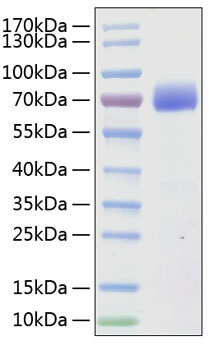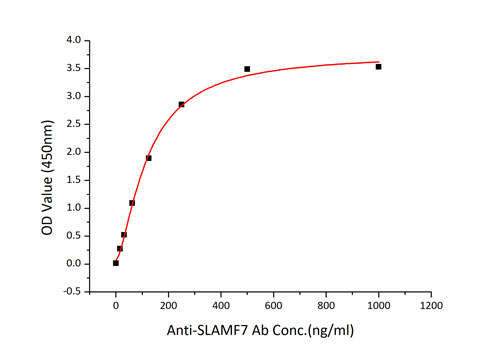Description
Recombinant Human SLAMF7/CRACC/CD319 Protein
The Recombinant Human SLAMF7/CRACC/CD319 Protein is a biologically active recombinant protein that plays a significant role in various cellular processes and signaling pathways in human biology. This protein is widely employed in immunological research, cell biology studies, protein-protein interaction analyses, and therapeutic development, providing researchers with a reliable tool for investigating SLAMF7/CRACC/CD319 function and its implications in health and disease.
This product (SKU: RPCB0387) is produced using HEK293 cells and features a C-hFc&His tag for convenient detection and purification. The protein exhibits a calculated molecular weight of 49.18 kDa with an observed molecular weight of 65-75 kDa under denaturing conditions, achieving ≥ 95 % as determined by SDS-PAGE.. Functional bioactivity has been validated through rigorous quality control assays, confirming its suitability for demanding research applications.
Key Features
| High Purity by Affinity Chromatography | |
| Mammalian & Bacterial Expression Systems | |
| High lot-to-lot consistency via strict QC |
| Product Name: | Recombinant Human SLAMF7/CRACC/CD319 Protein |
| SKU: | RPCB0387 |
| Size: | 10 μg , 20 μg , 50 μg , 100 μg |
| Reactivity: | Human |
| Synonyms: | SLAMF7, 19A, CD319, CRACC, CS1 |
| Tag: | C-hFc&His |
| Expression Host: | HEK293 cells |
| Calculated MW: | 49.18 kDa |
| Observed MW: | 65-75 kDa |
| Gene ID: | 57823 |
| Protein Description: | High quality, high purity and low endotoxin recombinant Recombinant Human SLAMF7/CRACC/CD319 Protein (RPCB0387), tested reactivity in HEK293 cells and has been validated in SDS-PAGE.100% guaranteed. |
| Endotoxin: | < 0.1 EU/μg of the protein by LAL method. |
| Purity: | ≥ 95 % as determined by SDS-PAGE. |
| Formulation: | Lyophilized from a 0.22 μm filtered solution of PBS, pH 7.4.Contact us for customized product form or formulation. |
| Bio-Activity: | Measured by its binding ability in a functional ELISA. Immobilized Recombinant Human SLAMF7 at 2 μg/mL (100 μL/well) can bind Anti-SLAMF7 antibody with a linear range of 60-150 ng/mL. |
| Reconstitution: | Centrifuge the vial before opening. Reconstitute to a concentration of 0.1-0.5 mg/mL in sterile distilled water. Avoid vortex or vigorously pipetting the protein. For long term storage, it is recommended to add a carrier protein or stablizer (e.g. 0.1% BSA, 5% HSA, 10% FBS or 5% Trehalose), and aliquot the reconstituted protein solution to minimize free-thaw cycles. |
| Storage: | Store at -20℃.Store the lyophilized protein at -20℃ to -80 ℃ up to 1 year from the date of receipt. After reconstitution, the protein solution is stable at -20℃ for 3 months, at 2-8℃ for up to 1 week. |
SLAM family member 7 (SLAMF7), also known as CRACC, CD319, CD2-like receptor-activating cytotoxic cells, and CS1, is a single-pass type I membrane protein and a member of the CD2 family of cell surface receptors. SLAMF7 is expressed on the surface of NK cells, CD8+ T cells, activated B cells, and mature dendritic cells but not in promyelocytic, B-cell lines, or T-cell lines. In human NK cells, activated SLAMF7 transmits signals following association with the adaptor protein EAT-2. In the absence of EAT-2, SLAMF7 potently inhibited natural killer cell function. It was also inhibitory in T cells, which are typically devoid of EAT-2. Thus, SLAMF7 can exert activating or inhibitory influences on cells of the immune system depending on cellular context and the availability of effector proteins.








